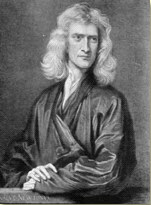|
|
 |
|
|
|
 |
| |
|
|
 |
Clouds & Particles
Basics |
Rainbow
Rainbows have always fascinated humans and carry lots of legends. Irish people said that a pot of gold lies at its end. Indians believed that it was a bridge between life and dead. The Genesis book tells rainbow is the sign of covenant between God and life on Earth. In reality, even if rainbows are so beautiful that they seem magic, there is nothing mysterious or supernatural in them. Let’s see here that it is only a meteorological phenomenon… |
|
|
|
|
 |
 |
 |
|
1. Sir Isaac Newton (1643 - 1727).
Source: NASA.
|
|
 |
The colours of white light
The famous English scientist Isaac Newton was the first to explain the rainbow in the 17th century, with the help of Descartes’ previous work on optical (Descartes was born in 1596 and died in 1650).
He showed that the sunlight is composed of several different colours, that human eye doesn’t see separately. Indeed, when you look at the sun at noon (be careful, don’t do it longer than a few seconds), it appears as white.
|
|
Light is in fact made of a series of colours: red, orange, yellow, green, blue, indigo and violet, called visible spectra.
It also comprises two other colours that we can’t see: infrared (that our eyes can’t detect but that our skin can feel, as heat) and ultraviolet (that cause sunburn).
|
 |
 |
|
2. The sun colour spectrum. Source: NASA.
|
The prism
Propagation of light is always rectilinear, but its direction can change when striking an obstacle. To demonstrate that white colour is in fact a mix of colours, Newton used a wedge of glass, called prism. When the light passes through a prism, it changes of direction (this is called refraction). The angle of bending is different for the various colours composing the light, giving seven distinct colours when light passes through the prism (see the picture). The light is said to be decomposed.
|
 |
 |
 |
|
3. Light being refracted by a prism. Author: J. Gourdeau. Click to enlarge! (10 K).
|
|
The rainbow
In order to see a rainbow, you know that two things are needed: sun (that must be in your back) and raindrops. When water droplets are suspended in the atmosphere, each of them act as a tiny prism. The sun shine through the raindrops and light is refracted, giving a rainbow. |
|
The shape of the rainbow
There is an angle of 42 degrees from the top of rainbow (red color) to the observer. And because this angle remains constant, your eyes see a semicircle somewhere in space. If you were in a plane, you may see a complete circle!
|
 |
 |
|
6. A rainbow would form an entire circle if the ground didn't get in the way.
Author: J. Gourdeau
|
Large raindrops (diameters of a few millimeters) give bright rainbows, whereas small drops (for example those existing in mist) produce paler rainbows.
You can create your own rainbow with a garden hose if it is sunny outside! Droplets of the sprinkler act in the same manner as the raindrops.
|
 |
 |
 |
|
7. Sometimes you can see a second rainbow, when two reflexions of light within the drop occur. The intensity of this secondary rainbow is much lower than that of the main one and the colours are reversed.
Author: J. Gourdeau
|
|
About this page...
Author: Justine Gourdeau, LAMP Clermont-ferrand, France. Scientific reviewing: Dr Frédéric Szczap, LaMP, France.
Date of generation: 2003-11-3. |
|
 |
|









